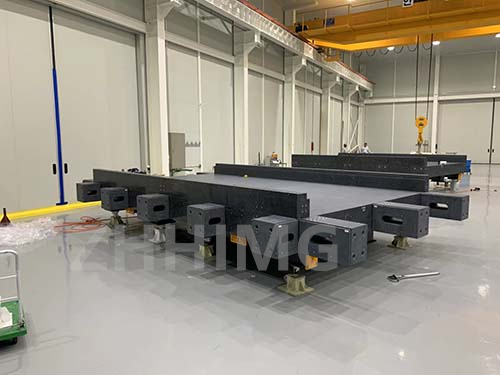Granite is a popular material for machine beds in wafer processing equipment due to its exceptional rigidity, high weight, and excellent resistance to wear and corrosion. However, even with these advantageous properties, granite machine beds are not immune to certain defects that may lead to decreased performance, precision, and reliability of the equipment. In this article, we will review some of the most common defects of granite machine beds for wafer processing equipment and suggest ways to address them.
1. Warp and bow
Granite is a natural material, and as such, it may contain slight variations in its dimensions and flatness. These variations can cause granite machine beds to warp or bow over time, which can affect the accuracy of the equipment. Additionally, heavy vibration or thermal cycling can exacerbate this issue. One way to resolve this problem is to choose granite with better dimensional stability and use fixturing to ensure that the machine bed stays flat.
2. Chipping and cracking
Granite is a hard and brittle material, which means that it can easily chip or crack if it is subjected to high impact or stress. These imperfections can cause the machine bed to become uneven, affecting the smoothness of movement of the wafer processing equipment. To prevent chipping and cracking, it is important to handle the granite machine bed with care during installation and operation. Additionally, it is a good idea to perform regular inspections to detect any signs of damage as soon as possible.
3. Surface roughness
The surface of a granite machine bed needs to be smooth and flat to ensure that the wafer processing equipment operates accurately and reliably. However, the machining process used to create the machine bed may leave behind surface roughness that can affect the performance of the equipment. To address this problem, it is important to carry out the machining process with care and use the appropriate tools and techniques to achieve the desired surface finish.
4. Staining and discoloration
Granite machine beds can become stained and discolored over time due to exposure to chemicals, water, and other substances. This can affect the aesthetic appeal of the equipment and lead to premature degradation of the granite material. To prevent staining and discoloration, it is important to use appropriate cleaning and maintenance procedures, including regular wiping and drying of the equipment after use.
5. Uneven distribution of weight
Granite machine beds are heavy, and if the weight is not distributed evenly, it can cause the equipment to become unstable and affect its precision and accuracy. To ensure that the weight is distributed evenly, it is important to use levelers and support stands during installation. Additionally, it is a good idea to perform regular weight inspections to detect any imbalances.
In conclusion, granite machine beds are a popular choice for wafer processing equipment due to their excellent properties. However, they are not immune to certain defects that can affect their performance, precision, and reliability. By following best practices and taking good care of the equipment, it is possible to address these issues and ensure that the equipment operates at optimal levels for years to come.
Post time: Dec-29-2023

